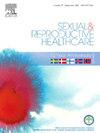“待在家里比去医院更好”——伴侣在怀孕期间如何体验胎儿心率的远程监控——一项定性访谈研究
IF 1.7
3区 医学
Q3 PUBLIC, ENVIRONMENTAL & OCCUPATIONAL HEALTH
引用次数: 0
摘要
健康远程监测,也称为远程监测,越来越多地用于产妇保健。妊娠复杂的妇女被要求在家监测自己和胎儿。定量研究表明,远程监控对女性来说是安全且可接受的,但对伴侣的角色和远程远程监控经验的了解很少。由于伴侣在家庭形成中的作用至关重要,助产士需要更多地了解伴侣的观点。目的探索合作伙伴如何体验远程监控。方法对14例复杂妊娠妇女的伴侣进行定性访谈研究。结果我们创建了五个主题:1)对医疗系统的基本信任,2)合作伙伴的角色,3)时间和时机问题,4)技术的可用性,5)在家很棒。合作伙伴认为远程监控节省时间和成本效益。然而,这对伴侣仍然遇到了从工作中请假的障碍;因此,尽管有些人希望参加远程监控,但他们没有参加。结论合作伙伴体验到远程监护的好处和挑战,并发现好处大于挑战。合作伙伴赞赏在家中对孕妇进行监测,这既节省时间又具有成本效益。它节省了时间,因为孕妇可以呆在家里,而且它具有成本效益,因为远程监控允许伴侣在不休假的情况下支持他们的配偶。节省了交通和停车费用。远程监控的挑战包括技术问题、注册截止日期、反馈时间和远程监控期间的兄弟姐妹管理。试注册UCN (UCN电子文件管理系统第219623号)本文章由计算机程序翻译,如有差异,请以英文原文为准。
“Being at home instead of going to the hospital is Great” − how partners experience telemonitoring of the fetal heart rate during pregnancy – A qualitative interview study
Introduction
Remote monitoring of health, also called telemonitoring, is increasingly used in maternity care. Women with complicated pregnancies are asked to monitor themselves and the fetus at home. Quantitative research indicates that telemonitoring is safe and acceptable for women, but knowledge about the partner’s role and experience of remote telemonitoring is sparse. As the partner’s role in family formation is essential, midwives need to know more about the partner’s perspective.
Aim
To explore how partners experience telemonitoring.
Methods
A qualitative interview study comprising 14 partners of women with complicated pregnancies.
Results
We created five themes: 1) Fundamental trust in the healthcare system, 2) The partner’s role, 3) Time and timing matters, 4) Usability of the technology, and 5) Being at home is great.
Discussion
The Partners experienced telemonitoring as timesaving and cost-effective. However, the partners still experienced barriers to taking time off from work; thus, some did not participate in telemonitoring at home despite their wish to attend.
Conclusion
The partners experienced both benefits and challenges with telemonitoring and found the benefits to outweigh the challenges. The partners appreciated that the pregnant woman was monitored at home, which was both time-saving and cost-effective. It saved time because the pregnant woman could stay at home, and it was cost-effective because telemonitoring allowed the partners to support their spouse without taking a day off work. Transportation and parking expenses were saved. Telemonitoring challenges included technical issues, registration deadlines, feedback timing, and managing siblings during telemonitoring.
Trial registration
UCN (J. No 219623 in the Electronic Document Management System at UCN)
求助全文
通过发布文献求助,成功后即可免费获取论文全文。
去求助
来源期刊

Sexual & Reproductive Healthcare
PUBLIC, ENVIRONMENTAL & OCCUPATIONAL HEALTH-
CiteScore
2.70
自引率
5.60%
发文量
73
审稿时长
45 days
 求助内容:
求助内容: 应助结果提醒方式:
应助结果提醒方式:


